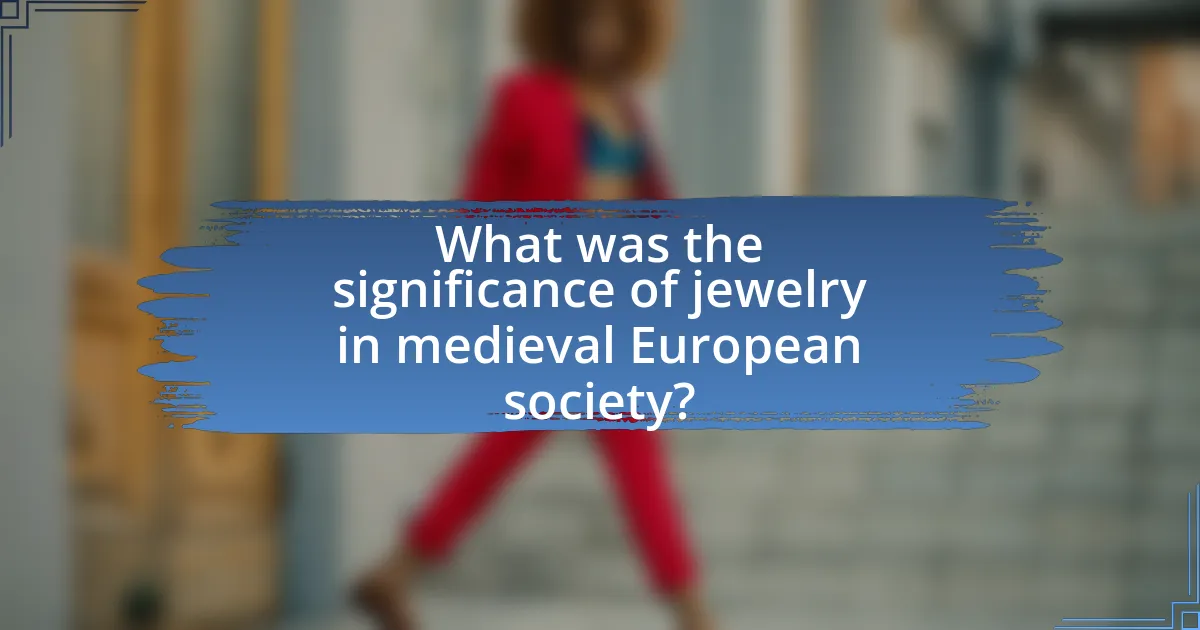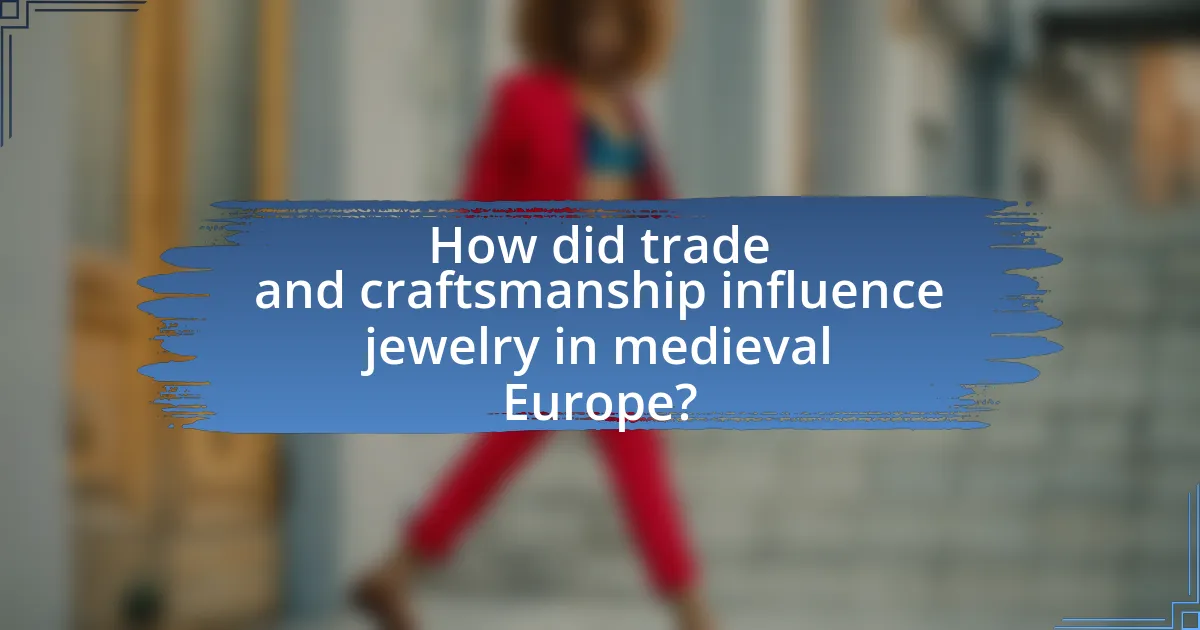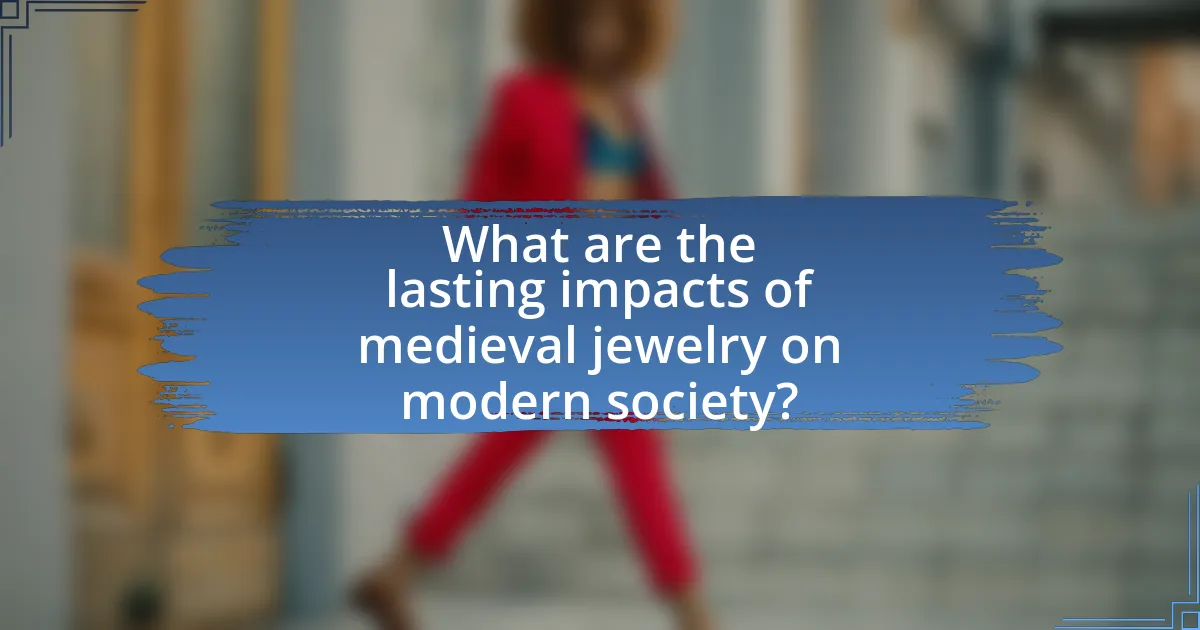The article examines the significant role of jewelry in medieval European society, highlighting its social, economic, and cultural importance. Jewelry served as a symbol of wealth and status, particularly among nobility, and functioned as a form of currency and a means of securing alliances. The craftsmanship of jewelry reflected artistic achievements of the time, while the materials used indicated social class distinctions. Additionally, the article explores how jewelry was utilized in personal expression, religious practices, and ceremonies, as well as the impact of trade and technological advancements on jewelry design and production. Lastly, it discusses the lasting influences of medieval jewelry on contemporary society and the lessons that can be drawn from its historical significance.

What was the significance of jewelry in medieval European society?
Jewelry held significant social, economic, and cultural importance in medieval European society. It served as a symbol of wealth and status, with nobles and royalty often wearing elaborate pieces to display their power and influence. For instance, the use of gold and precious gemstones in jewelry indicated high social standing, as these materials were expensive and difficult to acquire. Additionally, jewelry functioned as a form of currency and a means of securing alliances through gifts and dowries, further emphasizing its economic role. The craftsmanship involved in creating jewelry also reflected the artistic achievements of the time, showcasing the skills of artisans and contributing to the cultural heritage of medieval Europe.
How did jewelry reflect social status and wealth during the medieval period?
Jewelry during the medieval period served as a clear indicator of social status and wealth, with its materials, craftsmanship, and design reflecting the owner’s rank. Nobility and wealthy merchants adorned themselves with gold and silver pieces, often embellished with precious gemstones, which were rare and expensive, signifying their affluence. For example, the use of intricate designs and elaborate settings in jewelry was typically reserved for the upper classes, while simpler, less ornate pieces were common among the lower classes. Historical records indicate that sumptuary laws regulated the types of jewelry individuals could wear based on their social standing, further reinforcing the connection between jewelry and social hierarchy.
What types of jewelry were most commonly worn by the nobility?
Nobility commonly wore ornate jewelry such as rings, brooches, necklaces, and earrings. These pieces often featured precious metals like gold and silver, adorned with gemstones such as diamonds, rubies, and emeralds, reflecting their wealth and status. Historical records indicate that during the medieval period, jewelry served not only as decoration but also as symbols of power and alliances, with specific pieces often passed down through generations as family heirlooms.
How did the materials used in jewelry signify different social classes?
The materials used in jewelry signified different social classes by reflecting wealth and status, with precious metals and gemstones indicating higher social standing. For instance, nobles and royalty often adorned themselves with gold, silver, and rare gemstones like diamonds and emeralds, which were not only expensive but also difficult to obtain, thus symbolizing their elevated position in society. In contrast, lower classes typically wore jewelry made from less expensive materials such as base metals or glass, which were more accessible and affordable. Historical records show that during the medieval period, sumptuary laws regulated the types of materials individuals could wear based on their social rank, further reinforcing the connection between jewelry materials and social class.
In what ways did jewelry serve as a form of personal expression?
Jewelry served as a form of personal expression in medieval European society by reflecting individual identity, social status, and personal beliefs. Individuals used jewelry to signify their wealth and rank, as seen in the elaborate designs and precious materials used by nobility, which distinguished them from lower classes. Additionally, jewelry often carried personal significance, such as family heirlooms or religious symbols, allowing wearers to express their heritage and faith. Historical records indicate that specific pieces, like brooches and rings, were often inscribed with personal messages or symbols, further emphasizing their role in conveying personal narratives and values.
What symbols and motifs were prevalent in medieval jewelry design?
Medieval jewelry design prominently featured symbols and motifs such as crosses, animals, and floral patterns. Crosses represented faith and were often used in religious contexts, reflecting the strong influence of Christianity during the medieval period. Animal motifs, including lions and eagles, symbolized strength and nobility, frequently associated with heraldry and the status of the wearer. Floral patterns, particularly those inspired by nature, conveyed beauty and were common in decorative elements, showcasing craftsmanship and artistry. These motifs not only served aesthetic purposes but also conveyed social status, religious beliefs, and personal identity within medieval European society.
How did personal adornment vary between genders in medieval society?
Personal adornment in medieval society varied significantly between genders, with men typically favoring functional and less ornate items, while women adorned themselves with elaborate jewelry and accessories. Men often wore simpler adornments such as belts, brooches, and rings, which served practical purposes and indicated status without excessive decoration. In contrast, women utilized a wider array of jewelry, including necklaces, earrings, and intricate headdresses, which were often made from precious metals and gemstones, reflecting wealth and social standing. Historical records, such as illuminated manuscripts and inventories from the period, illustrate this gender disparity, showcasing the more elaborate and decorative nature of women’s adornment compared to the more utilitarian approach of men.
What role did jewelry play in religious and cultural practices?
Jewelry served as a significant symbol in religious and cultural practices during medieval European society. It was often used to signify status, wealth, and devotion, with specific pieces designed for religious ceremonies, such as crosses and reliquaries, which held sacred relics. Historical records indicate that jewelry was integral to rites of passage, including weddings and christenings, where it symbolized blessings and protection. Additionally, the use of gemstones was believed to possess spiritual properties, enhancing the wearer’s connection to the divine. For instance, the use of gold and silver in ecclesiastical jewelry reflected the church’s wealth and power, reinforcing its authority within society.
How was jewelry used in ceremonies and rituals?
Jewelry was used in ceremonies and rituals as a symbol of status, wealth, and religious significance in medieval European society. It adorned individuals during important events such as weddings, coronations, and religious ceremonies, reinforcing social hierarchies and personal identities. For instance, during weddings, rings and other ornaments signified the union and commitment between partners, while crowns and elaborate jewelry worn by royalty during coronations highlighted their divine right to rule. Historical records indicate that specific pieces, like the coronation regalia of European monarchs, were imbued with sacred meanings, often believed to possess protective or blessing qualities.
What significance did religious symbols in jewelry hold for medieval Christians?
Religious symbols in jewelry held significant meaning for medieval Christians as they served as expressions of faith and reminders of spiritual beliefs. These symbols, such as crosses and saints’ images, were often worn to signify one’s devotion to Christianity and to invoke divine protection. Historical evidence indicates that jewelry adorned with religious motifs was commonly used in both personal adornment and as gifts, reinforcing social bonds and communal identity among believers. Additionally, such jewelry often functioned as a form of talisman, believed to provide spiritual benefits and safeguard the wearer against evil.

How did trade and craftsmanship influence jewelry in medieval Europe?
Trade and craftsmanship significantly influenced jewelry in medieval Europe by enhancing the availability of materials and the sophistication of design. The expansion of trade routes during this period facilitated the importation of precious metals and gemstones from distant lands, such as gold from Africa and sapphires from Asia, which enriched the quality and variety of jewelry. Additionally, skilled artisans developed advanced techniques in metalworking and gem setting, leading to intricate designs that reflected the social status and wealth of the wearer. For instance, the emergence of guilds in cities like Florence and Paris established standards for craftsmanship, ensuring that jewelry was not only beautiful but also durable and finely made. This combination of accessible resources and refined skills resulted in jewelry that played a crucial role in expressing identity and status within medieval society.
What were the primary sources of materials for jewelry making?
The primary sources of materials for jewelry making in medieval European society included precious metals, gemstones, and organic materials. Precious metals such as gold and silver were mined from various locations, with significant sources including the mines in Germany and the Iberian Peninsula. Gemstones, including diamonds, rubies, and emeralds, were often imported from regions like India and the Middle East, reflecting trade routes established during the period. Organic materials, such as pearls and coral, were sourced from the sea, while materials like ivory and bone were derived from animals. These sources provided the essential components for creating intricate jewelry that symbolized wealth and status in medieval society.
How did the trade routes impact the availability of precious stones and metals?
Trade routes significantly increased the availability of precious stones and metals by facilitating their movement across regions. These routes connected areas rich in natural resources, such as India and the Middle East, with European markets, allowing for the importation of diamonds, rubies, gold, and silver. Historical evidence shows that during the medieval period, the Silk Road and maritime trade routes enabled the exchange of these valuable commodities, leading to a greater supply in Europe. For instance, the influx of gold and silver from the Americas in the late 15th century further enhanced the availability of these metals, impacting jewelry production and consumption in medieval European society.
What role did guilds play in the production of jewelry?
Guilds played a crucial role in the production of jewelry during medieval European society by regulating craftsmanship, ensuring quality, and controlling trade practices. These organizations established standards for materials and techniques, which helped maintain the reputation of jewelers and their products. For instance, guilds often required members to complete apprenticeships, ensuring that only skilled artisans could produce jewelry. Additionally, guilds enforced rules regarding pricing and competition, which protected their members from unfair practices. This structured environment not only fostered innovation in jewelry design but also contributed to the economic stability of the trade, as evidenced by the significant presence of guilds in major cities like Paris and London during the 14th and 15th centuries.
How did technological advancements affect jewelry design and production?
Technological advancements significantly transformed jewelry design and production by introducing new materials, techniques, and tools. The development of metalworking techniques, such as casting and soldering, allowed artisans to create more intricate and durable designs. For instance, the invention of the lost-wax casting method in the medieval period enabled jewelers to produce detailed and complex shapes that were previously unattainable. Additionally, advancements in gemstone cutting techniques improved the quality and brilliance of stones, enhancing their appeal in jewelry. The introduction of tools like the bow drill and the use of lapidary machines further streamlined production processes, allowing for greater efficiency and precision in crafting jewelry pieces. These innovations not only elevated the aesthetic value of jewelry but also made it more accessible to a broader audience in medieval European society.
What innovations in techniques emerged during the medieval period?
Innovations in techniques during the medieval period included advancements in metallurgy, gemstone cutting, and enameling. Metallurgy saw the introduction of new alloys, such as bronze and silver, which enhanced the durability and aesthetic appeal of jewelry. Gemstone cutting techniques evolved significantly, with the development of faceting that allowed for greater light reflection and brilliance in stones. Enameling techniques, particularly cloisonné and champlevé, became popular, enabling intricate designs and vibrant colors in jewelry pieces. These innovations contributed to the sophistication and artistry of medieval jewelry, reflecting the period’s cultural and economic growth.
How did these advancements influence the styles of jewelry created?
Advancements in metallurgy and gemstone cutting during the medieval period significantly influenced the styles of jewelry created. The development of techniques such as goldsmithing allowed for more intricate designs and the use of filigree, which enhanced the aesthetic appeal of jewelry. Additionally, the introduction of faceted gemstones, made possible by improved cutting methods, led to a greater emphasis on brilliance and color in jewelry pieces. Historical records indicate that these advancements resulted in a shift towards more elaborate and ornate styles, reflecting the wealth and status of the wearer, as seen in the intricate designs of ecclesiastical and royal jewelry from that era.
What were the economic implications of jewelry trade in medieval Europe?
The economic implications of jewelry trade in medieval Europe included the stimulation of local economies and the establishment of trade networks. The jewelry trade created demand for precious metals and gemstones, leading to increased mining and craftsmanship, which in turn generated employment and wealth in regions like Germany and Italy. Additionally, the trade facilitated connections between different regions, enhancing commerce and cultural exchange, as evidenced by the flourishing markets in cities such as Venice and Paris during the 14th century. This trade not only contributed to the wealth of merchants and artisans but also played a role in the rise of a wealthy merchant class that influenced political power and social structures in medieval society.
How did jewelry trade contribute to the wealth of cities and regions?
The jewelry trade significantly contributed to the wealth of cities and regions by generating substantial economic activity and attracting skilled artisans. In medieval Europe, cities such as Venice and Florence became wealthy centers of trade due to their strategic locations and established trade routes, facilitating the exchange of precious metals and gemstones. The demand for luxury items like jewelry created jobs for craftsmen and merchants, leading to increased local production and commerce. For instance, the rise of goldsmiths and jewelers in these cities not only enhanced their economic status but also established them as cultural hubs, further driving wealth accumulation through tourism and trade fairs.
What impact did jewelry have on social mobility and economic status?
Jewelry significantly impacted social mobility and economic status in medieval European society by serving as a symbol of wealth and social standing. The possession of ornate jewelry often indicated higher social rank, as it was typically owned by nobility and affluent merchants, thereby reinforcing class distinctions. Historical records show that during the medieval period, individuals adorned with gold and precious stones were perceived as more powerful and influential, which facilitated their ability to ascend socially and economically. For instance, sumptuary laws in various regions restricted the wearing of certain types of jewelry to specific classes, further emphasizing its role as a marker of social hierarchy. This correlation between jewelry and status not only influenced personal identity but also affected marriage prospects and alliances, as families sought to elevate their standing through strategic unions that included the exchange of valuable jewelry.

What are the lasting impacts of medieval jewelry on modern society?
The lasting impacts of medieval jewelry on modern society include the influence on contemporary jewelry design, the symbolism associated with adornment, and the preservation of craftsmanship techniques. Medieval jewelry often featured intricate designs, gemstones, and symbolic motifs, which continue to inspire modern jewelers in their creations. For instance, the use of filigree and cloisonné techniques, prevalent in medieval pieces, can still be seen in today’s artisan jewelry. Additionally, the symbolism of jewelry as a status indicator or a marker of personal identity, rooted in medieval practices, persists in modern culture, where jewelry often signifies wealth, commitment, or personal expression. Historical records, such as those from the 14th century detailing the adornments of nobility, illustrate how these practices have evolved yet remain relevant in contemporary society.
How has medieval jewelry influenced contemporary jewelry design?
Medieval jewelry has significantly influenced contemporary jewelry design through its intricate craftsmanship, symbolism, and use of materials. The detailed metalwork and gemstone settings from the medieval period are echoed in modern designs, showcasing a revival of techniques such as cloisonné and filigree. Additionally, the symbolic meanings attributed to medieval jewelry, such as love, status, and protection, continue to inspire contemporary pieces that convey personal narratives and emotional connections. Historical examples, such as the use of heraldic motifs and religious iconography, have also been adapted into modern jewelry, reflecting a blend of tradition and innovation in today’s designs.
What elements of medieval jewelry are still popular today?
Elements of medieval jewelry that remain popular today include intricate metalwork, gemstone settings, and symbolic motifs. Intricate metalwork, characterized by detailed craftsmanship, is evident in contemporary jewelry designs that emphasize artistry and skill. Gemstone settings, particularly the use of colored stones like sapphires and emeralds, reflect the medieval practice of showcasing precious gems, which continues to be a favored choice in modern jewelry. Additionally, symbolic motifs such as crosses and heraldic symbols, which were prevalent in medieval pieces, are still embraced for their historical significance and aesthetic appeal in today’s jewelry collections.
How do modern interpretations of medieval jewelry differ from historical designs?
Modern interpretations of medieval jewelry differ from historical designs primarily in materials, craftsmanship, and aesthetic choices. While historical medieval jewelry often utilized materials like gold, silver, and precious stones, modern interpretations frequently incorporate alternative materials such as resin, glass, and even recycled metals, reflecting contemporary values of sustainability and accessibility.
Additionally, historical designs were characterized by intricate craftsmanship and symbolic motifs that conveyed status and identity, whereas modern interpretations may prioritize minimalism or personal expression over traditional symbolism. For example, contemporary jewelers might create pieces inspired by medieval styles but adapt them to suit modern tastes, resulting in simplified forms and innovative designs that deviate from the original complexity.
These differences highlight a shift in focus from historical accuracy to personal interpretation and modern relevance, demonstrating how contemporary artisans reinterpret the past to resonate with today’s audience.
What lessons can be learned from the role of jewelry in medieval society?
The role of jewelry in medieval society teaches that it served as a significant indicator of social status and wealth. Jewelry was not merely decorative; it functioned as a symbol of power and prestige, often worn by nobility and wealthy merchants to display their economic standing. For instance, the use of gold and precious stones in jewelry was exclusive to the upper classes, reflecting their affluence and influence within the feudal system. Additionally, jewelry often held personal and cultural significance, such as engagement rings or religious symbols, which reinforced social bonds and traditions. This illustrates how jewelry was intertwined with identity and societal structure during the medieval period.
How can understanding medieval jewelry enhance our appreciation of cultural heritage?
Understanding medieval jewelry enhances our appreciation of cultural heritage by revealing the social, economic, and artistic values of the time. Jewelry from the medieval period often served as a status symbol, indicating wealth and power, as seen in the intricate designs and use of precious materials like gold and gemstones. For instance, the use of specific motifs, such as religious symbols or heraldic emblems, provides insight into the cultural and spiritual beliefs of medieval society. Additionally, the craftsmanship involved in creating these pieces reflects the technological advancements and artistic trends of the era, showcasing the skills of artisans. By studying these artifacts, we gain a deeper understanding of the historical context, social hierarchies, and cultural exchanges that shaped medieval European society.
What practical tips can be applied when studying or collecting medieval-inspired jewelry?
To effectively study or collect medieval-inspired jewelry, focus on researching historical context, materials, and craftsmanship techniques. Understanding the significance of jewelry in medieval society, such as its use in status display and religious symbolism, enhances appreciation and authenticity in collections. Additionally, examining reputable sources, such as museum collections and academic publications, provides insights into design variations and regional styles. Engaging with expert communities, attending workshops, and visiting historical sites can further deepen knowledge and inform purchasing decisions. Collectors should also verify provenance and authenticity through documentation and expert appraisal to ensure the integrity of their pieces.


